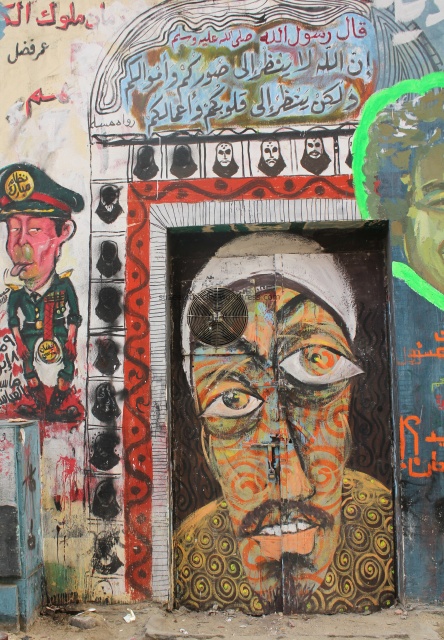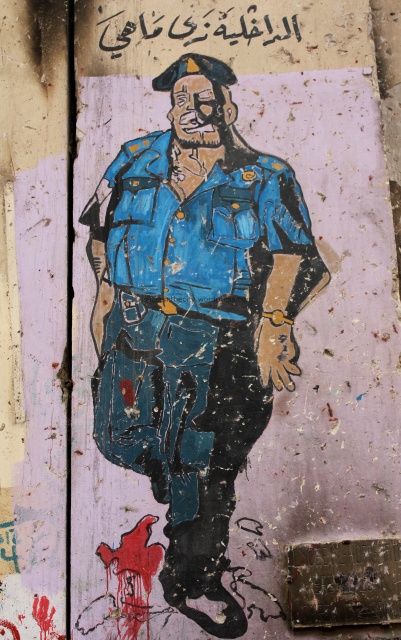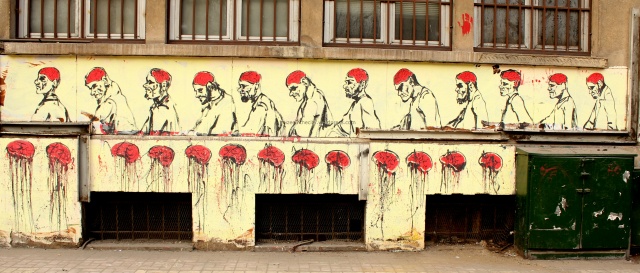It was my first time to walk through Tahrir after three months away from Egypt, and I don’t quite know why I was so bewildered and shell-shocked. Perhaps it was the heaviness of the atmosphere in the square, the squalid tents and crowds of resilient protesters holding onto the last threads of dying hope.
Perhaps it was the fact that the Mogamaa building was open and didn’t stink of urine anymore, or perhaps it was the graffiti of dead people’s faces on each and every wall. New names, old faces, the same old vows of vindication and justice. And so many young people; 15-year-olds, school children.
It’s hard to explain how nothing has changed yet everything has; how the space I once found home in is now an alien square to me. The people we’ve lost, medics, children, football fans, mothers and men of God, they’re now too many to remember. And it’s almost two years to January 25.

These are the real faces of the victims of police&military brutality, beaten and tortured to death, including Khaled Said
The Mohamed Mahmoud wall remains the most powerful tribute to the revolution, with Ammar Abo Bakr’s new message ‘If the picture needs to be made clearer, Sir, reality is more brutal, and as for the state’s response [to the martyrs]: saying it’s God’s Will means there will be no compensation to the families’.
The faces of Khaled Said, Esam Atta and two others are painted in their grotesque last shapes, bleak images of police brutality beyond imagination. Ammar added ‘And here are fifty kids like Anas’. Anas was the youngest victim of the Port Said clashes. The number fifty is probably a reference to the victims of the Assiut train crash of last month, whose faces and names have been drowned out and forgotten in our distraction with the referendum.

the distorted face of a Sheikh, presumably by Iyad Oraby. A saying by the Prophet Mohamed PBUH reads: God does not look at your appearances and your money, but at your hearts and your deeds.

The martyrs Mina Daniel and Sheikh Emad Effat, both in galabeyas, Muslim and Christian, with their hands spread out over the faces of many other martyrs
This mural carries the faces of smiling martyrs: Ramy Ramzy, Essam Atta, Ahmed Sorour, Sally Zahran, Ahmed Saleh, Asmaa, Hossam Radwan, Khaled Omar…. the names are endless. And it’s heartbreaking. It’s equally heartbreaking to see that someone placed a photo of his son Mostafa Helmy El Said, martyred in December 2011, with dried flowers around his frame, next to Sheikh Emad Effat. Mostafa was a student at El Azhar, Sheikh Emad was a teacher.
Then of course there was this Koranic verse that some newspapers panicked about and reported as salafi graffiti – had they taken the time to do minimal research, they’d have recognised the font, the colour and the statement as that of Ammar Abo Bakr’s, who first painted koranic verses on the AUC Greek campus wall and Mansour Street. The verse loosely translates to a reference of those who once they take power, destroy the earth and ignore the heed to obey God and claim to have God in their hearts but they are bound for hell.

Alaa Awad returns with his beautiful cave-like drawings of gazelles in flight, with slogans by 6 April and Ultras graffiti
It was shocking to see the Lycee school in such destitute remains, with the trees chopped down to their roots and the walls full of soot and shrapnel, to see the graffiti of so many smiling faces pleading to be remembered and vindicated, and to know that I can do nothing nor help in any way to vindicate them.
![Alaa Awad returns with a pharaonic mural that reads 'I am the guardian of the Eastern gates; the [Mer3a] shall not return again](https://suzeeinthecity.files.wordpress.com/2012/12/alex-tahrir-222s.jpg?w=640&h=420)
Alaa Awad returns with a pharaonic mural that reads ‘I am the guardian of the Eastern gates; the [Mer3a] shall not return again
But today, the street feels like a museum of ghosts, not only of the dead, but of the fighting, the fighting spirit and the resilient hope for change, and in some sense, of me, an Egyptian who felt part of something massive and life changing and is now left with faces on a wall.

The Wall will fall, a new layer on top of the massive smile painted by Amr Nazeer, Zeft and Laila Magued

El Husseiny [Abo Deef] was a journalist at El Fagr who died this month in clashes at Itihadeya after he was shot in the head. The stencil simply reads ‘Who’s next after me?’
I don’t know at what point I started crying while taking these photographs, maybe it was the plea under Ahmed Saleh’s face ‘Remember Me’, but a kid walked by and laughed at me, and called to his friends that el khawageya is crying. I wanted to tell him ‘my brothers died on this street’ even though I’ve never met them.

‘Gada3 ya Basha’ is a reference to the Eye sniper of the Mohamed Mahmoud clashes, who was caught on camera being applauded by his fellow soldiers for shooting protesters in the eyes

Next to the now famous portrait of Mubarak’s face with Tantawi/El Morshed by Omar Picasso is a granite plaque paying tribute to the martyrs of the revolution.

A poem by Amal Donqol ends with the statement ‘the martyr remains more glorious and greater than his killers’. An incredibly touching tribute















Great work, amazing pictures. did you take those yourself?
all watermarked photos are my own, otherwise i indicate that they are courtesy of the source
Pingback: Egyptian Graffiti and Gender Politics: An Interview with Soraya Moreyef – Africa is a Country
take a look at this: http://www.inplaceofwar.net/